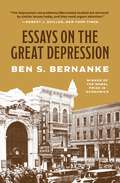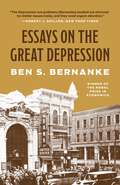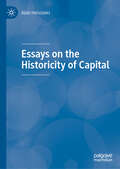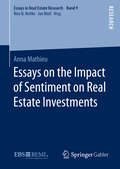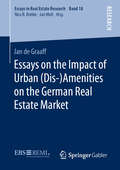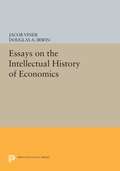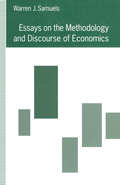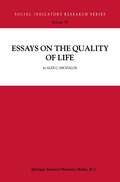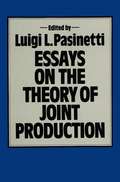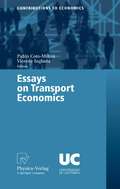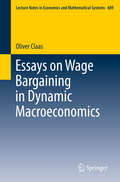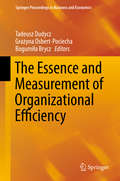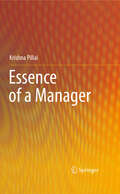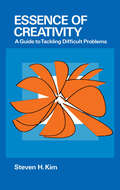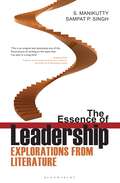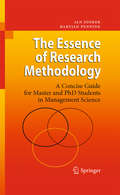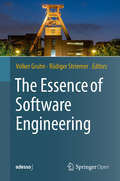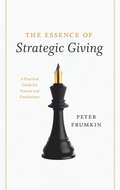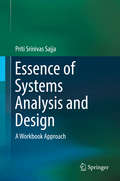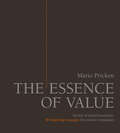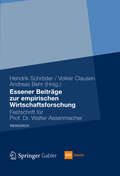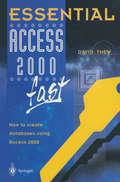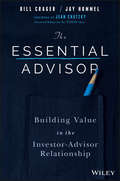- Table View
- List View
Essays on the Great Depression
by Ben S. BernankeFew periods in history compare to the Great Depression. Stock market crashes, bread lines, bank runs, and wild currency speculation were worldwide phenomena--all occurring with war looming in the background. This period has provided economists with a marvelous laboratory for studying the links between economic policies and institutions and economic performance. Here, Ben Bernanke has gathered together his essays on why the Great Depression was so devastating. This broad view shows us that while the Great Depression was an unparalleled disaster, some economies pulled up faster than others, and some made an opportunity out of it. By comparing and contrasting the economic strategies and statistics of the world's nations as they struggled to survive economically, the fundamental lessons of macroeconomics stand out in bold relief against a background of immense human suffering. The essays in this volume present a uniquely coherent view of the economic causes and worldwide propagation of the depression.
Essays on the Great Depression
by Ben S. BernankeFrom the Nobel Prize–winning economist and former chair of the U.S. Federal Reserve, a landmark book that provides vital lessons for understanding financial crises and their sometimes-catastrophic economic effectsAs chair of the U.S. Federal Reserve during the Global Financial Crisis, Ben Bernanke helped avert a greater financial disaster than the Great Depression. And he did so by drawing directly on what he had learned from years of studying the causes of the economic catastrophe of the 1930s—work for which he was later awarded the Nobel Prize. Essays on the Great Depression brings together Bernanke&’s influential work on the origins and economic lessons of the Depression, and this new edition also includes his Nobel Prize lecture.
Essays on the Great Depression
by Ben S. BernankeFrom the Nobel Prize–winning economist and former chair of the U.S. Federal Reserve, a landmark book that provides vital lessons for understanding financial crises and their sometimes-catastrophic economic effectsAs chair of the U.S. Federal Reserve during the Global Financial Crisis, Ben Bernanke helped avert a greater financial disaster than the Great Depression. And he did so by drawing directly on what he had learned from years of studying the causes of the economic catastrophe of the 1930s—work for which he was later awarded the Nobel Prize. Essays on the Great Depression brings together Bernanke&’s influential work on the origins and economic lessons of the Depression, and this new edition also includes his Nobel Prize lecture.
Essays on the Historicity of Capital
by Alain HerscoviciThe methodological and epistemological problem this book studies is related to the heterogeneity of capital. Capitals are heterogeneous through time and space; at the same time, various heterogeneous capitals must be aggregated, as shown by Ricardo and Keynes. On the other hand, the value of some quantity of aggregate capital changes over time, as demonstrated by Ricardo, Keynes and Stiglitz. For this purpose, this book considers Ricardo, Keynes and Stiglitz. For each author, capital is heterogeneous: Ricardo, from his labor theory; Keynes from the change in expectations, in regard to the return of such capital; and Stiglitz from the divergences between the different groups’ expectations. Ricardo was the first author who explained why the value of capital cannot be determined independently from distribution variables and consequently why such value changes when distribution variables change — this mechanism was deepened by Sraffa and the neo-Ricardian school. Keynes, with the concept of supply price of capital, explains why such value moves in regard to long-term expectations. Finally, Stiglitz’s analysis is a complementary approach in regard to Keynes’s, insofar as he details the mechanism of speculation observed by Keynes from asymmetries of information. Keynes and Stiglitz’s approaches allow complement Ricardo’s analysis, insofar expectations are absent from Ricardo’s framework. This book argues that epistemological choices allow going beyond the traditional opposition between neo-Ricardian and post-Keynesian approaches, introducing path dependence mechanisms and an “expectational” dimension. From the moment that capital is not a constant value over time and space, it is not possible anymore to consider a well-behaved production function, which this book argues implies refuting all the neoclassical framework, from the stability of the macroeconomic equilibrium and the Marshallian market equilibrium to the convergence towards the steady state.
Essays on the Impact of Sentiment on Real Estate Investments (Essays in Real Estate Research)
by Anna MathieuAnna Mathieu clarifies if real estate decisions are affected by investor and consumer sentiment and how severely the sentiment should be considered. With regard to international capital markets Mathieu conducts an analysis of the impact of investor sentiment on the return of the real estate-specific investment vehicle “Real Estate Investment Trust (REIT)” by applying a GARCH-Model. She investigates the effects of investor sentiment on the return and the underlying volatilities of REITs and Non-REITs during the financial crisis. The hypotheses are tested for validity in a GARCH-Model. Parallel to capital markets and thereby in changing from an indirect Real Estate investment perspective to a direct perspective the author conducts an analysis if consumer sentiment impacts the household decision to buy a new home in the US. Therefore a dataset with 385 monthly observations from 1978 to 2010 is tested by a component model.
Essays on the Impact of Urban (Essays in Real Estate Research #18)
by Jan de GraaffUnderstanding the relationship between urban amenities and real estate prices is a key for the future of our cities. Location choices depend on a variety of urban amenities that eventually determine demand for a specific location. Identifying the impact of these urban amenities on the people’s preferences allows policy makers and developers to increase quality of life. Jan de Graaff therefore quantifies the impact of crime and migration on residential real estate prices and identifies the location choice preferences of Germans by applying innovative methodologies to unique German data sets.
Essays on the Intellectual History of Economics
by Jacob Viner Douglas A. IrwinRanking among the most distinguished economists and scholars of his generation, Jacob Viner is best remembered for his work in international economics and in the history of economic thought. Mark Blaug, in his Great Economists Since Keynes (Cambridge, 1985) remarked that Viner was "quite simply the greatest historian of economic thought that ever lived." Never before, however, have Viner's important contributions to the intellectual history of economics been collected into one convenient volume. This book performs this valuable service to scholarship by reprinting Viner's classic essays on such topics as Adam Smith and laissez-faire, the intellectual history of laissez-faire, and power versus plenty as an objective of foreign policy in the seventeenth and eighteenth centuries. Also included are Viner's penetrating and previously unpublished Wabash College lectures. "Jacob Viner was one of the truly great economists of this century as both teacher and scholar. This collection ... covers a wide range with special emphasis on the history of thought. Today's economists will find [the essays] just as thought-provoking and as illuminating as did his contemporaries. They have aged very well indeed."--Milton Friedman, Hoover Institution "Jacob Viner was a great and original economic theorist. What is rarer, Viner was a learned scholar. What is still rarer, Viner was a wise scientist. This new anthology of his writings on intellectual history is worth having in every economist's library--to sample at intervals over the years in the reasoned hope that Viner's wisdom will rub off on the reader and for the pleasure of his writing."--Paul A. Samuelson, MIT "I am frankly jealous of those who will be reading Viner's essays for the first time, marvelling at his learning, amused by his dry wit, instructed by his wisdom. But although I cannot share their joy of discovery, I shall be able to savor the subtleties that emerge from rereading these splendid essays."--George J. Stigler, University of Chicago "This volume will be a treat for the reader who appreciates scholarship, felicitous use of language, and the workings of a great mind. The Wabash lectures are gems, and the introduction by Douglas Irwin contributes significantly to our understanding of Viner's accomplishments."--William J. Baumol, Princeton University/New York UniversityOriginally published in 1991.The Princeton Legacy Library uses the latest print-on-demand technology to again make available previously out-of-print books from the distinguished backlist of Princeton University Press. These editions preserve the original texts of these important books while presenting them in durable paperback and hardcover editions. The goal of the Princeton Legacy Library is to vastly increase access to the rich scholarly heritage found in the thousands of books published by Princeton University Press since its founding in 1905.
Essays on the Methodology and Discourse of Economics
by Warren J. SamuelsContains a collection of articles on economics as a system of discourse and on certain epistemological problems of economics. The treatment of both topics centres on the role of often implicit assumptions as to whose interests count in reaching conclusions especially as to policy.
Essays on the Quality of Life (Social Indicators Research Series #19)
by Alex C. MichalosSince initiating the journal Social Indicators Research in 1974, Alex C. Michalos has been a pioneer in social indicators and quality-of-life research. This collection of nineteen articles provides an overview of nearly 30 years of work, including papers drawn from diverse sources and papers never published before. The final paper, on multiple discrepancies theory (MDT), is the author's unique contribution to an empirically testable new foundation for theories of utility, satisfaction and happiness.
Essays on Transport Economics (Contributions to Economics)
by Pablo Coto-Millán Vicente IngladaThis book explores analytical methods used in transportation economics and policy analysis. Encompassing fields of economics such as Industrial Organisation, Welfare Economics, General Equilibrium Theory and Input-Output-Analysis, the study of transport from an economic point of view serves as a test bench for applying methodologies of economic science to the real world. Each chapter opens with a brief theoretical introduction before evaluating case studies, using the state-of-the-art statistical and econometric techniques.
Essays on Wage Bargaining in Dynamic Macroeconomics (Lecture Notes in Economics and Mathematical Systems #689)
by Oliver ClaasThis book addresses collective bargaining in an intertemporal monetary macroeconomy of the aggregate supply–aggregate demand (AS–AD) type with overlapping generations of consumers and with a public sector. The results are presented in a unified framework with a commodity market that clears competitively. By analyzing the implications of three variants of collective bargaining – efficient bargaining in a uniform and a segmented labor market and “right-to-manage” wage bargaining – it identifies the quantity of money, price expectations, union power, and union size as the determinants of temporary equilibria. In the three scenarios, it characterizes and compares the temporary equilibria using both analytical and numerical techniques, with an emphasis on allocations, welfare, and efficiency. It also discusses the dynamic evolution under rational expectations and its steady states in nominal and real terms. Lastly, it demonstrates conditions for stability regarding a balanced monetary expansion of the economy.
The Essence and Measurement of Organizational Efficiency (Springer Proceedings in Business and Economics)
by Tadeusz Dudycz Grażyna Osbert-Pociecha Bogumiła BryczThis book offers a collection of studies on various organizations’ efficiency, criteria for evaluating efficiency, together with tools and methods for measuring efficiency. The articles included present an interdisciplinary look at efficiency, its essence and the principles of its measurement. They represent an attempt to seek the conceptual boundaries of efficiency, i.e. to clarify this abstract and multidimensional concept including its relation to innovation, competitiveness and intellectual capital. The contributions also identify a broad spectrum of conditions for achieving efficiency in various types of organizations and systems (e.g. health care, hybrid organizations, non-profit organizations), representing various industries (e.g. insurance, banking, tourism, agriculture).
Essence of a Manager
by Krishna PillaiWhat makes a “good” manager? This is a book by a manager about managers but it is not just for managers. It is for anyone and for everyone who is interested in the way people – and not just managers - behave and function around the world. Based on actual experience the title “Essence of a Manager” is a succinct distillation of what this book is about. It is not a management manual and yet it is a map for navigation and a guide for behavior which can be valuable for practicing managers at all levels. It formulates a sound thesis to describe the qualities needed in a “good” manager and builds up from elemental qualities to develop a holistic view of a good manager. Nine fundamental attributes are proposed as being necessary and sufficient to describe a “good” manager. It is applied management philosophy for a thinking manager and deals with the fundamental drivers which lie deeper than language or culture and which control human behavior.
The Essence of Leadership: Explorations from Literature
by S Manikutty Sampat SinghUnderstanding leadership is really about understanding life, and this starts with gaining an understanding of the self. Traditional management approaches, based on 'scientific' analysis, cannot contribute much towards understanding leadership. This book shows how leadership can be better understood by reading and interpreting masterpieces of world literature, and relating them to leadership issues. The book starts with Cervantes' masterpiece Don Quixote, whose main character asserts, 'I know who I am', and believes in himself. This is followed by other works to highlight important issues: ambition and purpose in Chinua Achebe's Things Fall Apart, faith vs. reason in Bertolt Brecht's The Life of Galileo, awakening the human spirit in Bernard Shaw's Saint Joan, authenticity in Girish Karnad's Tughlaq, and the old Sanskrit play Mudra Rakshasa by Visakhadatta, leaders and society in Arthur Miller's All My Sons, the role of illusions in Ibsen's The Wild Duck, taking a stand in A Dolls' House, the epic Mahabharata for development of perspective, and Herman Hesse's Siddhartha for understanding the process of self-development and realisation of one's potential. Based on the experience of the authors teaching a course on leadership for the last 20 years at the Indian Institute of Management, Ahmedabad, this is an enlightening and illuminating read for both academicians and corporate leaders.
The Essence of Research Methodology: A Concise Guide for Master and PhD Students in Management Science
by Jan Jonker Bartjan PenninkMethodology is the ?eld which is indisputably complex. In the academic world, it is often said to be important, yet in everyday academic practice, it is not always treated accordingly. In teaching, methodology is often a mandatory course. Usually, it consists of learning how to adopt several common approaches when doing research, and how to conceive a research design (often leading to a survey). This usually leads to collecting data on a modest scale and – when the opportunity arises – analysing the data with the help of some statistics. Ask the students of their opinion at the end of such a course and they tend to heave a deep sigh of relief and say, “I have got through it. ” Then their real courses start again, in which methodology often does not play a role at all. We are of the opinion that writing-off methodology in this way is a real pity. It ignores the valuable role that methodology should play in academic teaching as a whole. Here, methodology is presented as a form of thinking and acting that, while obviously entailing research work, can also include the design and change of organisations. This broad approach has been purposefully chosen, as it is almost obvious from research and graduation projects that the students do not really have a clue what methodology involves and, therefore, wasting their time by producing work that has a little quality.
The Essence of Software Engineering
by Volker Gruhn Rüdiger StriemerThis open access book includes contributions by leading researchers and industry thought leaders on various topics related to the essence of software engineering and their application in industrial projects. It offers a broad overview of research findings dealing with current practical software engineering issues and also pointers to potential future developments.Celebrating the 20th anniversary of adesso AG, adesso gathered some of the pioneers of software engineering including Manfred Broy, Ivar Jacobson and Carlo Ghezzi at a special symposium, where they presented their thoughts about latest software engineering research and which are part of this book. This way it offers readers a concise overview of the essence of software engineering, providing valuable insights into the latest methodological research findings and adesso’s experience applying these results in real-world projects.
The Essence of Strategic Giving: A Practical Guide for Donors and Fundraisers
by Peter FrumkinIn the face of global financial problems and stressed government budgets, the ability of private philanthropy to step in and help solve public problems—and support vital private institutions as well—has perhaps never been more important. But how can donors be sure their contributions will be effective? And how can fundraisers make their case for support in a way that is compelling and productive? With The Essence of Strategic Giving, Peter Frumkin distills the lessons of his comprehensive, award-winning study, Strategic Giving, into a concise, practical guide for everyone involved in private philanthropy, from donors to managers of nonprofits to fund-raisers. He defines five critical challenges that all donors must address if their philanthropy is to amount to more than indiscriminate charity, including being aware of the time frame that guides a gift, specifying the intended impact being pursued, and recognizing how a donation fits with a donor’s own identity and style. Acknowledging and understanding these fundamental, strategic aspects of giving, Frumkin argues, will help ensure philanthropy that more effectively achieves its aims—and at the same time builds a lasting relationship between donors and the institutions they support. As the next generation of donors wrestle with the challenge of effectively distributing what Andrew Carnegie called “surplus wealth,” Frumkin’s road map will be an indispensible resource for years to come.
Essence of Systems Analysis and Design: A Workbook Approach
by Priti Srinivas SajjaThe main objective is to provide quick and essential knowledge for the subject with the help of summary and solved questions /case studies without going into detailed discussion. This book will be much helpful for the students as a supplementary text/workbook; and to the non-computer professionals, who deal with the systems analysis and design as part of their business. Such problem solving approach will be able to provide practical knowledge of the subject and similar learning output, without going into lengthy discussions.Though the book is conceived as supplementary text/workbook; the topics are selected and arranged in such a way that it can provide complete and sufficient knowledge of the subject.
The Essence of Value: Secrets of Desired Products- 80 Inspiring Strategies for Creative Companies
by Mario PrickenFor his new book, Mario Pricken has thoroughly analyzed more than 300 products, objects and events over their entire lifecycles in order to reveal, for the first time, the patterns that make things extraordinarily valuable. On the basis of his analysis, he has identified 80 parameters that can be found, for example, in the biographies of exceptional cars, watches, luxury foods, designer furniture, artwork and services - such as the elements of uniqueness, scarcity, the effect of time or magnificently orchestrated transfers of ownership. In addition, the book provides a comprehensive catalog of questions to help us generate our own ideas for giving products that special something which transforms them into objects of desire. "The Essence of Value" is an inspiring book for progressive, creative people involved in product development, marketing, design, events and the arts as well as recommended reading for those who appreciate fine things and want to understand what makes products particularly special and valuable. The book focusses on intuition and understanding, but it also inspires and entertains, offering us an entirely new way of looking at the creation, marketing and purchase of truly desirable products. This travel guide through the world of valuable products and objects - reveals, based on examples from the worlds of business, the arts and religion, and with numerous accompanying illustrations, the fundamental parameters that create value and make products "shine" - can be used as an analytical tool to quickly and easily determine the "value-DNA" of a product - provides over 300 thought-provoking questions to inspire new ideas on how to imbue products with value - shows professionals a clear and practical application of the value parameters.
Essener Beiträge zur empirischen Wirtschaftsforschung: Festschrift für Prof. Dr. Walter Assenmacher
by Hendrik Schröder Volker Clausen Andreas BehrDie empirische Wirtschaftsforschung schlägt die Brücke von der reinen Theorie zu empirischen Aussagen über Sachverhalte in der Praxis. Sie ist in der Fakultät für Wirtschaftswissenschaften an der Universität Duisburg-Essen ein Schwerpunkt in Forschung und Lehre. Alle Autorinnen und Autoren dieses Buches arbeiten am Campus Essen oder haben einen Teil ihres akademischen Werdegangs in Essen absolviert. Das breite Spektrum unterstreicht die Anwendungsvielfalt empirischer Forschung in den Wirtschaftswissenschaften.
Essential Access 2000 fast: How to create databases using Access 2000 (Essential Series)
by David ThewIf you are new to Access 2000 or already use an alternative database application and you want to switch to Access 2000 this book gives you all the essential information you need using lots of examples.Topics covered in this book include:- How to use the Access interface- How to use Access objects to create a simple database- How to use built in functions- How to create tables- How to create forms- How to create queries to select and update data- How to create reports- How to create macros- How to use object events and create proceduresEssential Access 2000 fast is designed for professionals or students who need to learn the maximum in the minimum time and to develop databases fast.
The Essential Advisor: Building Value in the Investor-Advisor Relationship
by Bill Crager Jay HummelLeverage the financial services evolution to maximize your firm's value The Essential Advisor presents an insightful handbook for advisors looking to navigate the changing face of financial services. The industry is evolving, consumers are evolving, and many advisors are being left behind as old methods become less and less relevant. This book shows you how to turn this shift into a positive, by positioning your firm to maximize these new opportunities, and deliver the results and experience increasingly expected of financial advisors. You'll learn how to provide the transparency, hands-on interaction, and around-the-clock access today's clients demand, and how to consistently deliver service that robo-advisors cannot duplicate. Emerging technologies do not have to be a threat to your practice—they are tools that represent opportunities to provide greater service to your clients, and smart technology integration will be a hallmark of firms that survive the shift. This guide provides a clear vision of the future of financial services, and an indispensable management framework for maximizing your firm's future value. Advisors are increasingly confused about what clients are seeking, and clients are equally confused about what advisory firms offer that alternatives cannot. This book helps clear the air on both sides by examining the client's perspective of financial services, and helping advisors better communicate their strengths. Articulate the value of your services Leverage new technology to complement your practice Capitalize on opportunities and maximize your firm's value Position your firm to benefit from the changing consumer population Financial advisors can only grow their businesses if clients know what they do, know how to hire them, and can access them affordably. The Essential Advisor shows you to bring your firm into the future successfully.
The Essential Advisor: Building Value in the Investor-Advisor Relationship
by Bill Crager Jay HummelLeverage the financial services evolution to maximize your firm's value The Essential Advisor presents an insightful handbook for advisors looking to navigate the changing face of financial services. The industry is evolving, consumers are evolving, and many advisors are being left behind as old methods become less and less relevant. This book shows you how to turn this shift into a positive, by positioning your firm to maximize these new opportunities, and deliver the results and experience increasingly expected of financial advisors. You'll learn how to provide the transparency, hands-on interaction, and around-the-clock access today's clients demand, and how to consistently deliver service that robo-advisors cannot duplicate. Emerging technologies do not have to be a threat to your practice—they are tools that represent opportunities to provide greater service to your clients, and smart technology integration will be a hallmark of firms that survive the shift. This guide provides a clear vision of the future of financial services, and an indispensable management framework for maximizing your firm's future value. Advisors are increasingly confused about what clients are seeking, and clients are equally confused about what advisory firms offer that alternatives cannot. This book helps clear the air on both sides by examining the client's perspective of financial services, and helping advisors better communicate their strengths. Articulate the value of your services Leverage new technology to complement your practice Capitalize on opportunities and maximize your firm's value Position your firm to benefit from the changing consumer population Financial advisors can only grow their businesses if clients know what they do, know how to hire them, and can access them affordably. The Essential Advisor shows you to bring your firm into the future successfully.
